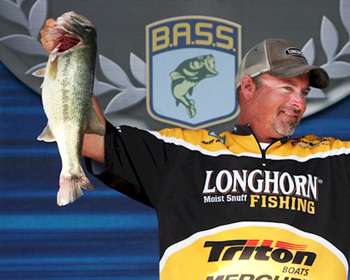
Elite Series pro Jeff Kriet readily admits that the shaky head worm has saved his hide in numerous tournaments and also put thousands of dollars in his pocket throughout the course of his tenure on the Bassmaster Elite Series.
When searching for the perfect shaky head, Kriet looks at three things: the diameter of the hook, the weight of the head and the mechanism used for attaching the worm to the head of the jig.
"The most important thing on a shaky head is the diameter of the wire used for the hook. That's the No. 1 thing that I look at, no matter what brand I'm throwing," claims the Oklahoma pro. Kriet says that the main mistake many anglers make when selecting a shaky head is using a hook that is too thick.
That's because these lures generally are fished with a spinning rod and light line in deep water. A small diameter hook will penetrate the plastic and bury into the bass with much less pressure.
"You wouldn't take a flipping stick and spool it with 8-pound-test line and throw a light wire hook, so it doesn't make sense to throw a heavy wire hook on light line and a spinning rod," Kriet says.
Kriet has converted many of his colleagues on the Bassmaster Elite Series from thick gauge shaky head hooks to light wire heads, especially the ones he has been hand pouring in his shop for several years.
"The shaky head hook that I just designed for Jewel is, in my opinion, the perfect shaky head. It's going to scare a lot of people because of the thin diameter of the hook, but once they try it, they'll realize the benefits," he says.
Kriet also pays close attention to the weight of his shaky head. In many cases, the lighter the better.
"A 3/16-ounce head is probably the heaviest I'll ever throw — and that's just for extreme cases, such as when I'm fishing really deep in windy conditions. I'll throw a 1/8-ounce probably 90 percent of the time and a 1/16-ounce the rest of the time," he says.
If conditions warrant anything heavier, he will opt for a jig or Texas rig.
"With a 1/4-ounce head, the shaky head just doesn't do the things I want it to do; it's no longer finesse," he says. "The whole thing with a shaky head is that a lot of the bites come as the bait is falling."
The final component he looks for when selecting a shaky head is how the worm is attached to the head of the jig. If there's a spring, barb or locking device protruding directly from the jighead itself, he won't use it.
"If you have the head of your worm positioned at the same angle as your hook, it's difficult to get a good hook set because it keeps the worm from collapsing on the shank of the hook," he explains.
Kriet likes his worm keeper, be it a barb or a collar, positioned on the hook shank itself so that the worm can slide against the shank of the hook during the hook set.
"When you set the hook, the worm is already against the shank of the hook, so the hook pops through the worm and into the bass," says Kriet.




